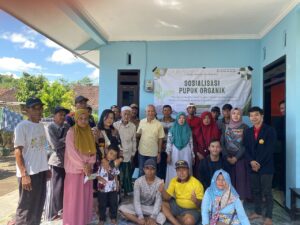 Participating in government programs in an effort to prevent stunting, the research team from the Department of Chemistry at FMIPA UNEJ developed organic fish hydrolyzate fertilizer. Using this fertilizer on rice plants can produce rice that has a high content of important minerals, namely zinc and iron. Rice with a high zinc content is needed to reduce stunting, and high iron content helps reduce anemia and maintain the body’s immune system. This was revealed during an educational event for the farming community in Karangrejo Village, Jember (21/4) that was organized by the FMIPA UNEJ Chemistry Student Association.
Participating in government programs in an effort to prevent stunting, the research team from the Department of Chemistry at FMIPA UNEJ developed organic fish hydrolyzate fertilizer. Using this fertilizer on rice plants can produce rice that has a high content of important minerals, namely zinc and iron. Rice with a high zinc content is needed to reduce stunting, and high iron content helps reduce anemia and maintain the body’s immune system. This was revealed during an educational event for the farming community in Karangrejo Village, Jember (21/4) that was organized by the FMIPA UNEJ Chemistry Student Association.
At yesterday’s educational meeting, apart from the farmers who were members of the Karangrejo farmer group, there was also PPL Mrs. Yatmi, who had also paid attention to the independent study activities of Chemistry Department students in Kranjingan Village, Jember. This is in line with Drs. Achmad Sjaifullah, M.Sc., Ph.D., who said that we never teach farmers to grow crops but accompany farmers to use fish hydrolyzate fertilizer. Mr. Sjai, nicknamed Drs. Achmad Sjaifullah, M.Sc., Ph.D., an activist for fish hydrolyzate organic fertilizer, also known as Tirta Sari Mina organic fertilizer, said research had been carried out since 2009. “After research, in 2014 we started testing and produced a scientific article discussing how easy it is to increase rice production with high zinc and iron content using fish hydrolyzate fertilizer,” he said.
Mr. Sjai said that rice produced from rice fertilized with hydrolyzed fertilizer will produce high levels of zinc, which is needed for the work of enzymes in the body’s metabolic processes. “We know the causes of stunting, one of which is low zinc intake. Rice fertilized with fish hydrolyzate will improve the quality of zinc contained in the staple food, namely rice,” he explained. It was also conveyed that this research could be said to have been carried out earlier than the distribution of Inpari IR Nutrizinc Rice around 2020, which was claimed to have the potential to contain up to 34 ppm of zinc, although the zinc levels in the rice produced actually varied greatly, 8.7–34 ppm from the rice planted in different areas.
The zinc content in various varieties of sosoh rice fertilized with fish hydrosate grown in several sub-districts in Banyuwangi and Jember reaches 28 ppm and iron up to 15 ppm. Apart from the high zinc content, the advantages of using fish hydrolyzate fertilizer for rice are that the plants bear fruit and harvest more quickly, increase crop yields, reduce plant pest attacks because they are not liked by insects such as leafhoppers, grasshoppers, and fruit flies, and most importantly, it does not harm the environment. Mr. Sjai said that the increase in zinc and iron in rice is also easy to predict by looking at the increase in harvest weight, weight of grain per sack, or weight per 1000 grains of grain. Then zinc will automatically increase too.
Present at the event was the Head of the Chemistry Department, FMIPA UNEJ, Prof. Dr. Anak Agung’s wife Ratnadewi, S.Si., M.Si., who provided welcome and support for these activities. It was explained again that the use of hydrolyzed fertilizer is easy. “Spray fertilizer once a week five times since the rice is just before budding; it will increase zinc twofold,” said Mr. Sjai. Then, when applying the fertilizer, you must shake it before adding water, filter it before entering the sprayer, carry out the dilution in a shaded place that is tightly closed, and finally, do not store the diluted fertilizer.
Collaboration between researchers from the Chemistry Department of FMIPA UNEJ and the Himpunan Mahasiswa Kimia (HIMAKI Zirconium) will continue to participate in preventing stunting in Indonesia through quality rice using hydrolyzed organic fertilizer. It also helps farmers increase crop yields, of course with quality rice too. At the end of the event, the head of the farmer’s group, Mr. Nugroho, conveyed the impression that the activity was useful and that he would try to fertilize using fish hydrolyzate, accompanied by student members of HIMAKI.
Nugroho added that he hopes that the event can continue and that both parties can build good cooperation to achieve good goals in the future. This was conveyed by the farmer leader because the Karya Krajan Baru II farmer group was already a legal entity. This means that cooperation with the Jember University campus can be easily established in the future. After the socialization event is complete, a demonstration plot will be held on one of the farmers’ land in order to compare agricultural results using the organic fertilizer “Tirta Sari Mirna” and those that do not use it.
Brosur SPO_revisi_optDownload




